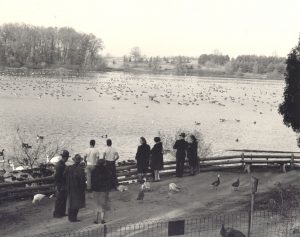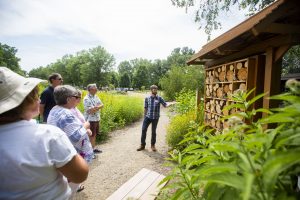Since its inception in 1927, the W.K. Kellogg Bird Sanctuary has built a legacy based on integrating conservation, research and community outreach.
The Sanctuary staff, throughout the past 90 years, has been instrumental in assisting with the repopulation of Canada Geese and Trumpeter Swans. Former Sanctuary director, Joe Johnson, worked in conjunction with the Michigan Trumpeter Swan Restoration Project to repopulate a nearly extinct waterfowl species. The Trumpeter Swan has not only re-established itself within the confines of the Sanctuary, but continues to see growth throughout Michigan in its native habitats.
The Sanctuary, located on Wintergreen Lake in Kalamazoo County, is a prime stopping point during spring and fall migration for a variety of species of waterfowl. In addition to creating a haven for migratory birds, past researchers have also participated in the banding of birds to not only track migratory birds but also aid in data collection to better understand the habits and population changes.
The Sanctuary hosts a large variety of bird species, but in recent years has also been expanding its habitat for pollinators. The pollinator garden, established in 2008, not only provides a natural habitat for a variety of pollinating species, but also includes man-made structures including a “bee spiral” and “bee condo” that are welcoming homes for bees to occupy. Bees in particular have seen significant declines in their population in recent years, and we see it as our responsibility to do our part to conserve them.
One of the greatest positive impacts humans can have on pollinators is to provide a habitat that attracts and hosts these amazing species. At the Sanctuary, this means a strong focus on native plant species.
“Historically, there just wasn’t much of an emphasis on planting native plants over non-native ornamentals, and there wasn’t an understanding of the ecological benefits of local plants,” said outreach fellow Sean Griffin. “This idea has really gained popularity over the last couple decades.”
These gardens serve as an education tool to exhibit how to approach gardening to incorporate native plants and the benefits of pollinators in their environment. The most recent garden expansion in 2018 added additional native species bringing the diversity to over 75 species, as well as updated interpretive signage for guests to explore and learn.
Guests are welcome at the Sanctuary 365 days a year, for a wide selection of events, educational programs, and tours.
The W.K. Kellogg Bird Sanctuary’s mission is to conserve native habitat for migratory and resident birds and through research, education, and outreach help people gain environmental awareness about our past, present and future. Visit their website to learn more.




A legacy of conservation; a commitment to sustainability.
3700 E. Gull Lake Drive
Hickory Corners, MI 49060
(269) 671-5117
info@kbs.msu.edu